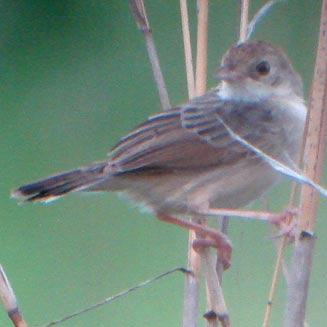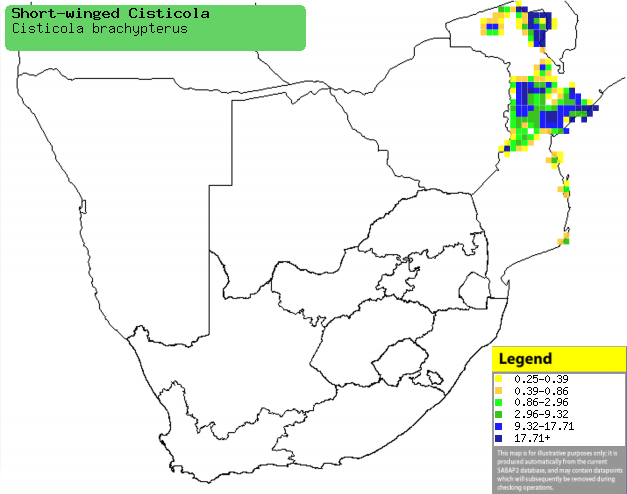|
Cisticola brachypterus
(Short-winged cisticola)
[= Cisticola brachyptera]
Kortvlerktinktinkie [Afrikaans]; Kortvleugel-graszanger [Dutch];
Cisticole à ailes courtes [French]; Kurzflügel-zistensänger [German];
Fuinha-d'asa-curta [Portuguese]
Life
> Eukaryotes >
Opisthokonta
> Metazoa (animals) >
Bilateria >
Deuterostomia > Chordata >
Craniata > Vertebrata (vertebrates) > Gnathostomata (jawed
vertebrates) > Teleostomi (teleost fish) > Osteichthyes (bony fish) > Class:
Sarcopterygii (lobe-finned
fish) > Stegocephalia (terrestrial
vertebrates) > Tetrapoda
(four-legged vertebrates) > Reptiliomorpha > Amniota >
Reptilia (reptiles) >
Romeriida > Diapsida > Archosauromorpha > Archosauria >
Dinosauria
(dinosaurs) > Saurischia > Theropoda (bipedal predatory dinosaurs) >
Coelurosauria > Maniraptora > Aves
(birds) >
Order: Passeriformes > Family: Cisticolidae
> Genus: Cisticola
 |
|
|
Short-winged cisticola, Shai Hills, Ghana. [photo
Nik Borrows
©] |
|
Distribution and habitat
It is widespread across sub-Saharan Africa, occurring from
west Africa to Ethiopia south to the southern African part of Mozambique. Here
it is locally common in clearings in woodland, especially miombo (Brachystegia)
but also other types of savanna woodland. It also occupies thickets with termite
mounds, vegetation along drainage lines and edges of cultivated areas.
|
 |
|
Distribution of Short-winged cisticola in southern Africa,
based on statistical smoothing of the records from first SA Bird Atlas
Project (©
Animal Demography unit, University of
Cape Town; smoothing by Birgit Erni and Francesca Little). Colours range
from dark blue (most common) through to yellow (least common). |
Food
It mainly eats insects, foraging unobtrusively in grass
tufts and on the ground. The following food items have been recorded
in its diet:
Breeding
- The nest is a compact ball shape with a side entrance, built of dry grass
and leaves reinforced with spider web. It is typically placed very near the
ground in a grass tuft or small shrub.
- In Zimbabwe the egg-laying season is from November-March.
- It lays 2-4 eggs, which are incubated solely by the female for about 14
days.
- The chicks stay in the nest for about 17 days.
Threats
Not threatened.
References
-
Hockey PAR, Dean WRJ and Ryan PG 2005. Roberts
- Birds of southern Africa, VIIth ed. The Trustees of the John Voelcker
Bird Book Fund, Cape Town.
|
